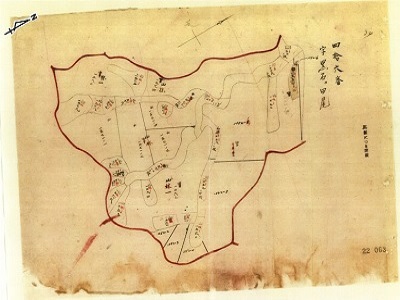 Forest
History Forest
History
Welcome to our forest history page. When we decided to purchase this property,
we had no idea of the deep history connected to this land. This is a timeline,
in reverse chronological order, of the owners, residents, and events connected
to this unique piece of real estate.
Graphic - Really old
map of our mountain property. |
|
|
|
July 2021 - Hayman clan
purchases forest. Yup we are now the new owners of this
beautiful and ancient land. This mountain has not ever been used, at least to
the best of our knowledge, except possibly by a hunter-gatherer and early
agriculturalist population during the Jomon Period in Japan traditionally dated
between c. 14,000–300 BCE |
 1979
- Saikyo Dam is built. The Saikyo Dam was built
in Nishinoomote City which not only provides drinking water to the city but also
supplies irrigation to the island communities of Yokoyama, Izeki, Anno, Genna,
Asakawa, Takebe, and Yajingo. Before the dam was built, the reservoir area was
rice fields (see old map at the top of the page) and open space. Once the dam
was built, a new parcel map was made which included the exact boundaries of our
mountain property. 1979
- Saikyo Dam is built. The Saikyo Dam was built
in Nishinoomote City which not only provides drinking water to the city but also
supplies irrigation to the island communities of Yokoyama, Izeki, Anno, Genna,
Asakawa, Takebe, and Yajingo. Before the dam was built, the reservoir area was
rice fields (see old map at the top of the page) and open space. Once the dam
was built, a new parcel map was made which included the exact boundaries of our
mountain property. |
1868 - Tanegashima clan.
The Tanegashima clan ruled the island until the Meiji restoration. The
Tanegashima clan enjoyed a high degree of autonomy until Shimazu unified
southern Kyūshū in the late 16th century, and after that, served as a
top-ranking retainer to the Satsuma domain. Following the Meiji restoration, the
island has been administered as part of Kagoshima Prefecture.
1543 - Firearms
introduced. European firearms were introduced to Japan. Until modern
times, firearms were colloquially known in Japan as "Tanegashima", due to the
belief that they were introduced by the Portuguese on board the first Portuguese
ship.
1336 - 1573 - Muromachi
period. During the Muromachi period, Tanegashima functioned as a relay
station for one of the main routes of Chinese trade that connected Sakai to
Ningbo. The Tanegashima clan cooperated with the Hosokawa clan, one of two
powers who controlled Chinese trade. The clan also maintained a firm connection
with the Honnō-ji Temple of Kyoto. These account for the rapid spread of
firearms from Tanegashima to central Japan.
1185 - 1333 - Kamakura
period. In the early Kamakura period, the positions of the land steward
of the Shimazu Estate and the military governor of Ōsumi Province were given to
the Shimazu clan. However, the clan lost these positions to the Hōjō clan, the
de facto ruler of the shogunate. The Hōjō clan sent the Higo clan as deputy
governors. A branch line of the Higo clan made itself autonomous on Tanegashima
after the Hōjō clan was annihilated and began to claim the clan name of
Tanegashima.
1185 - Knife industry
- Edge tools (particularly knives and scissors) made in Tanegashima are famous
traditional handicrafts in Japan. Craftsmen in Tanegashima have kept alive
traditional techniques for forging iron tools. Tanegashima is also famous as the
center of iron sand production. The technique has been around since about 1185
when the Taira clan were exiled here from Kyoto by Minamoto no Yoritomo, taking
with them craftsmen and chefs from Kyoto. The people of the island speak with a
Kyoto accent even now, rather than a Kyūshū or Kagoshima accent, despite its
proximity to Kyūshū. These craftsmen were the original users of the distinct
techniques used for forging. The technique is unique in the world, and produces
such tools as "Tanegashima Hōchō" (Tanegashima knives), used by chefs, and "Tane-basami"
(Tanegashima scissors), preferred by many for the art of Bonsai.
1140 - Shimazu Estate.
Tanegashima became part of the Shimazu Estate, the largest medieval shōen of
Japan. |
|
824 CE - Province merged.
Tane Province merged into Ōsumi Province.
702 CE - Province
established. Tane Province was established on the island.
699 CE - Paid tribute.
People from Tane went to the imperial court to pay tribute.
679 CE - Island mission.
The imperial court sent a mission to the island who returned in 681.
677 CE - Tanegashima
banquet. The imperial court hosted a banquet for the islanders of
Tanegashima.
300 CE - Yayoi culture.
Artifacts including magatama, an engraved pendant, and emblems with apparent
writing show evidence of a uniquely well-developed Yayoi period culture at the
end of the 4th century CE.
13,000 BCE - Tanegashima
separates from Kyushu. Around 13,000 BCE, or 15,000 years ago, the island
of Tanegashima began to separate from the island of Kyushu.
28,900 BCE - Evidence of
oldest island inhabitants discovered. With the discovery of the Tachikiri
Ruins on Tanegashima island, artifacts support the existence of inhabitants
dating back 30,900 years. This settlement is believed to be the oldest in Japan. |
|
|
|
|